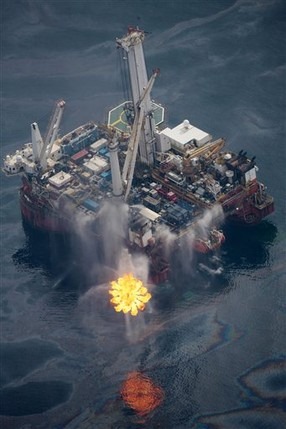Photo gallery: Aerial photos of oil and gas flaring at Deepwater Horizon site
By Marilyn Crain
June 18, 1:36 PM June 18, 2010 – The fight to contain the oil and gas spewing into the Gulf of Mexico goes on. While much of the news focus over the last few days has been on Washington, D.C. and BP executives meeting with the President and testifying before Congress, the oil continues to flow from the Deepwater Horizon ruptured wellhead. Oil and gas are being brought to the surface by the containment cap, the oil is being off-loaded and gas is being burned. Now, both oil and gas are being burned off after being captured by the reverse use of the top kill procedure apparatus. But, thousands of barrels still pour into the Gulf a mile below the surface. (See live view of oil spill.)
In his press briefing yesterday, Admiral Allen gave a few of the details, “While this has been going on, we’ve continued to produce oil out of the well head through the containment cap. As of yesterday though, we have the added capacity now what we call the Q4000 mobile drilling units on scene. It is actually drawing oil up through the kill pipe. That’s where we actually sent the mud down during the top kill operation. We’re actually using that as a way to evacuate more oil out in addition to what’s being produced by the Discoverer Enterprise.”
“We now, once we get these both operating, have the potential to bring our production capacity up to about 28,000 barrels a day. Probably by sometime early next week. They’ll bring the rates up slowly to make sure they can control it.”
“The Q4000, what we are doing is we’re bringing up both natural gas and oil and they’re both being flared off. There’s an EverGreen burning device on the Q4000 that looks much like the flaring device for natural gas but it’s capable of flaring the oil itself with natural gas in it, a fairly clean burn. Not nearly what the amount of smoke that you see for an in situ burning.” – From the briefing transcript
With each passing day, as more oil and gas pollute the waters of the Gulf of Mexico, the worst environmental disaster in United States’ history continues to grow more catastrophic with long range effects that scientists can’t yet begin to envision. …
Gulf oil spill: Controlled burns, Q4000, BP oil spill site activity, new aerial pictures, video




